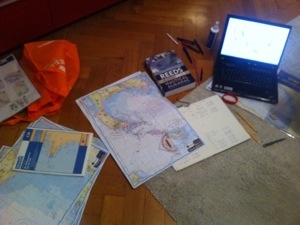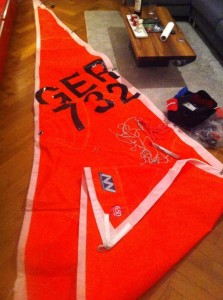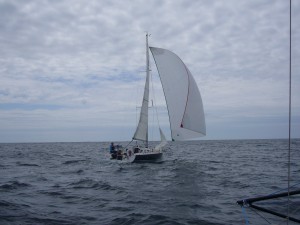
chartwork on a mini
Due to medical reasons I am not allowed to train right now (although luckily that ban is not for long any more) I am spending time preparing the season.
After having spliced the new parts of the running rigging (some new halyards, new sheets) and TEEM took care of the electronics on board I have time for some race prep – at least those bits that can be done at home.
A specialty of sailing a mini is that we aren’t allowed to carry GPS plotters with electronic seacharts so our GPS systems are only allowed to display positions and waypoints/routes.
If you consider that and the fact that I am dumbed down by sleep deprivation to a en extreme level of stupidity then you’ll understand that I try to prepare my seacharts idiot-proof.
My preparation looks about like this:
1. General waypoints
I’ll go through my paper seacharts and mark waypoints with a permanent pen, then I note those coordinates in a GPS waypoint manager on my laptop. I also write the waypoint with some additional notes into a separate list.
Every waypoint is identified by a 5 character code (the gps doesn’t allow more) so the waypoint “GLN_S” is the southern cardinal bouy of the Iles de Glenan.
The waypoints that I mark in this phase are important turning points, entry and exit points of narrow channels or shallows.
If an area is very complex then I try to plan possible ways to cross these waters and create “chains” of waypoints that I can later use as a route to get through that area. I will also write down the maximum allowed cross track error (XTE) for the way from one waypoint to the other. If the chart is very complex I also shade some areas on the paperchart so that at 4am when I look at those charts I understand what my original plan was.
All of these waypoints (overall about a hundred) are then uploaded from the Waypoint manager on my laptop to the GPS on board.
2. Laminate the charts
After the paper charts are prepared I laminate them to make them waterproof. This is great as I can then use them in the cockpit in rain or when we’re getting firehosed.
I take notes on the charts during the races with permanent markers which can be erased. That works great even with wet or salty charts.
3. Roadbook
The next step is to create a roadbook for each race.
The roadbook contains a general planning of the race course and its different stages. A possible stage could be Stage 2 of the Trophee Marie Agnes Peron: “Pt du Raz to Iles de Glenan.
For each stage I now try to identify how to sail this stage at different weather or tidal situation. For this I read the tidal atlas and general weather and tidal information I can get about a certain area (I use the Reed’s Nautical Almanach), i.e. between Belle-Ile and Ile-de-Quiberon. This step is rather important as due to the fast currents on the french atlantic coast the tide has a huge influence on your tactics, especially in conjunction with the wind.
If I have my (or other’s tracks) from the last year then that’s even better and can be analyzed to see what worked well and what didn’t.
4. The week before the race
About a week before the race I take the roadbook back out. From now on I will get fresh GRIB weather data daily and run them through the computer for a routing. These routings are not very useful yet though as the forecasts tend to become relatively reliable only for the next 48 hours.
I try to have the boat in shape as much as possible in these last two days so I can try to relax, get some sleep and have time to focus on the weather.
In these two days I will compare the two big weather models GFS and ECMWF to see where they differ as they will often predict slightly different front movements or general relocations of the weather systems.
The two models are also loaded into the routing software and I will run a couple of ensemble routings where the computer variies the windspeed, wind direction and boat speed.
If necessary, additional waypoints are programmed into the GPS already.
From now on the roadbook is read frequently to try and remember as much of it as possible.
5. Evening and Morning before the start
On the evening before the start I will usually run my final routings and take notes on possible what-if scenarios. Rough waypoints of the optimal routings are loaded into the GPS with the route for the race course.
The whole route including the waypoint coordinates, course and distance to the next mark, etc. are also printed and added to the roadbook on board.
The weather and routing is checked a final time at about 8am on race day (given that the weather models are ready and time permits). The latest forecasts are printed and if necessary final notes are added.
Before the start I will read the notes for the first stage.
If the preparation was good then the roadbook is a huge help. You can always compare the current situation with the prepared scenarios and adapt your plans as you go.
But the best preparation is no help if you don’t use the material. This happened to me last year where in the heat of the battle I forgot to read my notes on tides and got beat up badly at Ile de Groix and Chaussee de Sein.
Well, I guess these are the first notes I can add to my roadbook already.
My living room is not a sail loft
 After having had the chance to intensely test out my storm jib during training last november I realized that I needed two dyneema strops to be able to easily and properly attach the storm jib.
After having had the chance to intensely test out my storm jib during training last november I realized that I needed two dyneema strops to be able to easily and properly attach the storm jib.
One at the head to basically move the luff of the sail further up so when set the halyard is attached at the top of the babystay. This way the halyard can actually tighten the luff instead of just pulling the babystay up.
The other one at the tack to move the tack higher above deck. This way the carts for the genoa sheets can also be used for the storm jib effectively.
While doing that job in my living room I realized the sails don’t actually look that big while on board or in the sail loft so I’m glad I don’t have to carry out any similar work at home on my big solent or my main – that would become really tricky.
Training with Lorient Grand-Large / Tanguy Leglatin
It’s been a bit quiet here the last few months which was due to lack of time but not lack of sailing (luckily).
From october till early december I had the pleasure of participating in the training series organized by Lorient Grand-Large with world-class trainer Tanguy Leglatin.
I benefitted hugely from the training and even though at times it felt like I had to learn sailing from scratch I am sure I could not have figured out in a year what Tanguy taught me in those four weekends.
All the training sessions were doublehanded and I was lucky to find nice and fun crew in Katrina (www.katrinahamracing.com), my buddy Marten and Becky (www.beckyscottracing.com) and Nikki (www.nikkicurwen.com) with the Artemis Offshore Academy.
The weather offered us its full spectrum from absolute calm to 35 knots of wind and rain which allowed us to train our lee trim as well as reefing extensively.
Currently it’s time for boatwork, the seemingly neverending todo-list (and even worse: shopping-list) is starting to get smaller and the missing equipment is arriving as well.
End of january I am going to be back in france to get the boat ready for the new season, some training in february and march and then in april the new season officially begins with the first races of the atlantic coast.
Stay tuned for more news of smaller and larger modifications on board. In the meantime here’s my (first!) sailing video with photos and shots from the training and the 2012 season:
TMAP
I was lucky to be one of the first 20 boats to be towed out and was out at about 10:30 am which gave me ample time to calibrate my instruments and get a feel for the wind.
The start wasn’t so bad and I tacked to get some clean air on the right side when we got a lift and I stayed on the right until the end of the bay. Unhappily I didn’t manage to use the cape-effect the locals used and ended up without wind for quite a while – with other boats passing just 50m from me.

After Pointe du Raz it was downwind running towards Cape Caval and unhappily it showed that these conditions are not my sweet spot. I had huge issues to get the spinnaker standing properly and it took me until Iles-de-Glenans to stop losing on the other boats. I had lost a lot but the race was still young so I decided not to sleep until Ile de Groix to try and catch up a little.
The plan worked out alright and at Ile de Groix I had some boats ahead and was even able to overtake some. But then I got the current wrong and screwed up the marks north of Ile de Groix so I lost almost a mile there.
After leaving Ile de Groix to starboard it was foggy and we had very instable winds of 8 to 12 knots which was shifting a lot. The autopilot was struggling to keep the course so I had to steer manually, not too great as I had planned to catch some sleep. To make matters worse I also burned myself with boiling water while preparing tea – what a way to start the day.
At the southern mark I had overtaken one boat but I could feel the others breathe down my neck. After rounding I screwed up my spinnaker hoist and lost quite a lot again.
Now was THE decision to be made: offshore or inshore?
My plan was to go offshore but the wind was not as predicted so I didn’t trust the prediction and decided to stay about 4 miles offshore. Unhappily this meant plain downwind running again – and I had the same problems as before.
At 9 or 10 am on friday, the wind decreased a lot and I made some ground on a pogo2 ahead of me which finally went inshore – then the wind died down entirely and it was hard on my nerves to see the other boats disappear behind the horizon and see the boats offshore pass while we were idling around without any wind in perfect sunshine.
This was an interesting situation, the other pogo2 about 1,5 miles inshore of me and Alan with his Nacira about 1 mile further offshore.
At about 6pm the wind finally picked up and the race was on with a easterly wind of about 8 knots. The pogo2 inshore had a better angle and could sail higher and was soon about half a mile straight in front of me. I was able to sail higher and faster and at sunset I had managed to catch up about 200m on windward of him. I was happy: On the layline to the next mark (Chausee de Sein), I had wind and had the chance to eat something then we suddenly slowed down a lot. The wind had shifted by 60 degrees to the south. We both hoisted our gennakers but I had a major f***up and it tooke me two minutes longer to set it. By then the other pogo2 had won half a mile and we was pulling away: I simply couldn’t get the boat trimmed.
To make things worse, Alan was now able to sail upwind and in these conditions, pulled “up” to me onto the layline – as well half a mile in front of me.
I was tired (I hadn’t slept at all for 40hours), the wind died down and turned further so I even had to change to the spinnaker while the boats ahead of me pulled away with the Jib up. The tide was tricky and I had to be careful not to be pushed onto the rocks.
After passing Chaussee de Sein early morning we turned upwind to the buoy north of the entrance of bay de Douarnenez which was directly in wind direction so we had a long tack ahead of us. I turned the autopilot on to finally catch some sleep but after a minute my GPS and AIS turned off, the VHF was beeping like hell. I quickly figured out the cause: the batteries had 11.9 Volts – they were flat.
I was puzzled on why there were in such a bad state but had no time to investigate further: With a Red Bull and a Snickers I steered manually and waited for the sunrise to charge my batteries enough to at least use the navigation equipment until the finish line.
The tack was long and hard – my sleep deprivation now showed and it was hard to focus on my strategy. I was sure I was last and it was tricky to keep spirits up and keep going. About 2 miles before rounding the mark I suddenly spotted Alan in the bay and when he tacked for the buoy, I tacked onto the same line as him.
“If i’m going to finish last then at least not by much” I thought and was determined to catch up or at least not lose any more on Alan.
We were beating upwind in 10-12 knots and I relentlessly trimmed by boat and was able to point a degree higher and as fast or even a little faster than Alan and made good some ground. Then I screwed up the tack into the bay of Douarnenez (tacked back accidentally) and lost at least a minute. So I had to start all over again. The wind now turned a little south and we were able to lay the finish line, a short tack to round the final buoy, then it was a 12nm drag race towards the finish. We have a 1-1,5m chop, 16kn of wind at 50 apparent doing 6,5 to 7 knots. The AIS is great because I can see whether I am catching up on Alan. And I am in fact able to catch up – by trimming each gust (up to 23 knots in the bays) and about 2nm to the finish I am 2 boat lengths behind.
Now it is a close fight, Alan luffs me from time to time and we both have big smiles on our faces in this close race.
On the last half mile one unpleasant surprise: the germany cruising yacht “Kairos” decided to enter Douarnenez and motor right in front of us while we are approaching the line. My lack of sleep shows, I yell and am unfocused: and lose 1.5 bl within seconds.
Being one bl behind Alan, his mainsail suddenly opens up and starts flapping. I think his clutch gave way but he stands up and takes his head off to me. I open up my mainsail as well but I have some speed left so we both drift across the line me finishing first by 3 seconds and being sad that we didn’t make it to finish at the same time. The guy on the finish boat is shaking his head confused.
When I ask Alan about this later he tells me that he was so happy that we had such a great race and that I would not have deserved finishing last. What a great sportsman!
Back in Douarnenez we find out that we were not the last competitors so I finished as 45. out of 49 boats to finish.
Given that this was my first race in 2012 and my first solo race ever, this is ok. I learned a lot and know where I have to improve.
